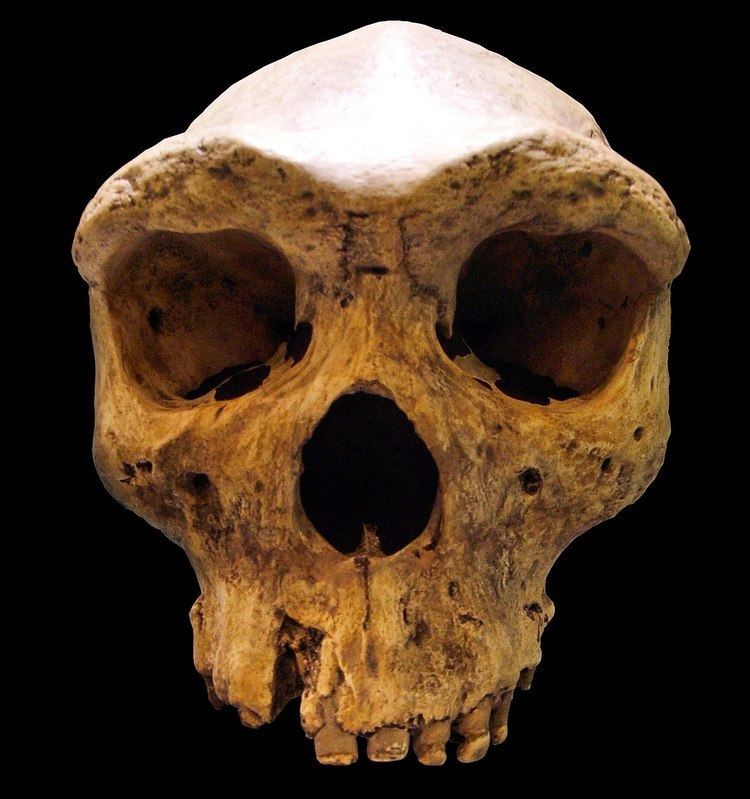 | ||
A number of varieties of Homo are grouped into the broad category of archaic humans in the period beginning 500,000 years ago (or 500ka). It typically includes Homo neanderthalensis (40ka-600ka), Homo rhodesiensis (125ka-300ka), Homo heidelbergensis (200ka-600ka), and may also include Homo antecessor (800ka-1200ka). This category is contrasted with anatomically modern humans, which include Homo sapiens sapiens and the subspecies Homo sapiens idaltu.
Contents
Modern humans are theorized to have evolved from archaic humans, who in turn evolved from Homo erectus. Varieties of archaic humans are sometimes included under the binomial name "Homo sapiens" (Latin: "wise man") because their brain size is very similar to that of modern humans. Archaic humans had a brain size averaging 1200 to 1400 cubic centimeters, which overlaps with the range of modern humans. Archaics are distinguished from anatomically modern humans by having a thick skull, prominent supraorbital ridges (brow ridges) and the lack of a prominent chin.
Anatomically modern humans appear from about 200,000 years ago and after 70,000 years ago (see Toba catastrophe theory), gradually supplanting the "archaic" human varieties. Non-modern varieties of Homo are certain to have survived until after 30,000 years ago, and perhaps until as recent as 10,000 years ago. Which of these, if any, are included under the term "archaic human" is a matter of definition and varies among authors. Nonetheless, according to recent genetic studies, modern humans may have bred with "at least two groups" of ancient humans: Neanderthals and Denisovans. Other studies have cast doubt on admixture being the source of the shared genetic markers between archaic and modern humans, pointing to an ancestral origin of the traits originating 500,000 to 800,000 years ago.
New evidence suggests another group may also have been extant as recently as 11,500 years ago, the Red Deer Cave people of China. Chris Stringer of the Natural History Museum in London has suggested that these people could be a result of mating between Denisovans and modern humans. Other scientists remain skeptical, suggesting that the unique features are within the variations expected for human populations.
Terminology and definition
The category archaic human lacks a single, agreed upon definition. According to one definition, Homo sapiens is a single species comprising several subspecies that include the archaics and modern humans. Under this definition, modern humans are referred to as Homo sapiens sapiens and archaics are also designated with the prefix "Homo sapiens". For example, the Neanderthals are Homo sapiens neanderthalensis, and Homo heidelbergensis is Homo sapiens heidelbergensis. Other taxonomists prefer not to consider archaics and modern humans as a single species but as several different species. In this case the standard taxonomy is used, i.e. Homo rhodesiensis, or Homo neanderthalensis.
The evolutionary dividing lines that separate modern humans from archaic Homo sapiens and archaic humans from Homo erectus are unclear. The earliest known fossils of anatomically modern humans such as the Omo remains from 195,000 years ago, Homo sapiens idaltu from 160,000 years ago, and Qafzeh remains from 90,000 years ago are recognizably modern humans. However, these early modern humans do possess a number of archaic traits, such as moderate, but not prominent, brow ridges.
Brain size expansion
The emergence of archaic humans is sometimes used as an example of punctuated equilibrium. This occurs when a species undergoes significant biological evolution within a relatively short period. Subsequently, the species undergoes very little change for long periods until the next punctuation. The brain size of archaic humans expanded significantly from 900 cubic centimeters in erectus to 1300 cubic centimeters. Since the peak of human brain size during the archaics, it has begun to decline.
Origin of language
Robin Dunbar has argued that archaic humans were the first to use language. Based on his analysis of the relationship between brain size and hominin group size, he concluded that because archaic humans had large brains, they must have lived in groups of over 120 individuals. Dunbar argues that it was not possible for hominins to live in such large groups without using language, otherwise there could be no group cohesion and the group would disintegrate. By comparison, chimpanzees live in smaller groups of up to 50 individuals.
